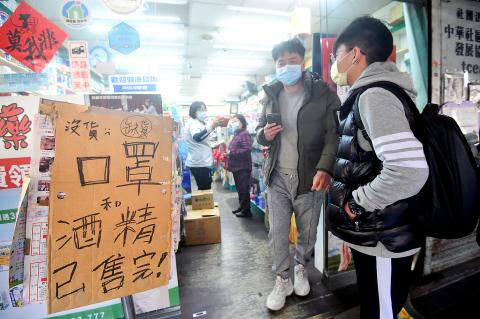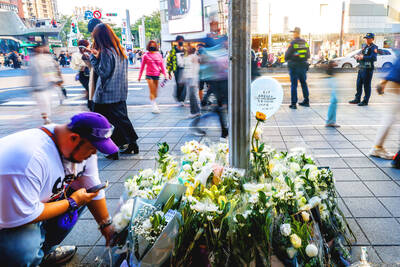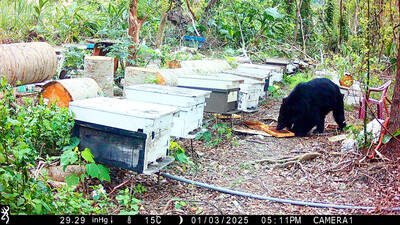The Central Epidemic Command Center (CECC) yesterday said that an outbreak of 2019 novel coronavirus (2019-nCoV) has not been detected in local communities, so people should not panic and stockpile masks.
The center also detailed three conditions for wearing a mask and five tips for putting on a mask properly.
The center said it held a coordination meeting with local governments’ civil affairs and health departments on Friday to discuss the mobilization of resources for disease control and prevention.

Photo: Fang Pin-chao, Taipei Times
The two indigenous cases of 2019-nCoV that have been confirmed in Taiwan were familial clusterings, and so far there is no evident risk of disease transmission in the community, the center quoted National Taiwan University Hospital’s Infectious Disease Division professor Chang Shan-chwen (張上淳) and Pediatrics Department director Huang Li-min (黃立民) as saying at the meeting.
The two doctors recommended that people wear a mask if they are “visiting a hospital or clinic, have respiratory symptoms or have a chronic disease,” the center said.
People who are healthy do not have to wear a mask at all times, it said, adding that students do not have to wear masks in class.
The pair also provided tips on how to put on a mask properly, including first making sure that the mask is intact and not damaged, and then securing the elastic loops behind the ears, pinching the upper metal band around the bridge of the nose, and extending the mask to fully cover the mouth, nose and chin.
Users should make sure the mask forms a tight seal on their face, the center said, adding that a mask should only be used by one person and should be replaced every day.
The center on Friday also extended the criteria for mandatory reporting of severe pneumonia with novel pathogens from China.
The first set of criteria includes people who have a fever (38°C and above) or acute respiratory infections, and have visited China’s Hubei Province or had direct contact with someone who had returned from Hubei and have developed a fever or respiratory infection within 14 days before the onset of symptoms
The second set includes people who have pneumonia and have visited China within 14 days before the onset of symptoms.
In related news, Minister of Health and Welfare Chen Shih-chung (陳時中) told a press conference at 7:55pm yesterday that the center has designated China’s Guangdong Province as a secondary endemic area.
Starting today, people returning from Guangdong must be tested for 2019-nCoV upon arrival in Taiwan and put under home quarantine for 14 days, while all visitors from Guangdong will not be allowed to enter Taiwan, he said.
In addition, people who return to Taiwan through the ”small three links” are to be placed under home quarantine for 14 days, starting today, he added.
Hubei Province remains a primary endemic area and all people returning from the province must test negative for 2019-nCoV in two examinations at a medical facility before they are allowed to leave.
As of 4pm yesterday, a total of 964 cases of severe pneumonia with novel pathogens were reported: 10 tested positive for 2019-nCoV infection, 746 were ruled out, and the rest remained in quarantine for further testing, the center said.

SHIPS, TRAINS AND AUTOMOBILES: The ministry has announced changes to varied transportation industries taking effect soon, with a number of effects for passengers Beginning next month, the post office is canceling signature upon delivery and written inquiry services for international registered small packets in accordance with the new policy of the Universal Postal Union, the Ministry of Transportation and Communications said yesterday. The new policy does not apply to packets that are to be delivered to China, the ministry said. Senders of international registered small packets would receive a NT$10 rebate on postage if the packets are sent from Jan. 1 to March 31, it added. The ministry said that three other policies are also scheduled to take effect next month. International cruise ship operators

HORROR STORIES: One victim recounted not realizing they had been stabbed and seeing people bleeding, while another recalled breaking down in tears after fleeing A man on Friday died after he tried to fight the knife-wielding suspect who went on a stabbing spree near two of Taipei’s busiest metro stations, Taipei Mayor Chiang Wan-an (蔣萬安) said. The 57-year-old man, identified by his family name, Yu (余), encountered the suspect at Exit M7 of Taipei Main Station and immediately tried to stop him, but was fatally wounded and later died, Chiang said, calling the incident “heartbreaking.” Yu’s family would receive at least NT$5 million (US$158,584) in compensation through the Taipei Rapid Transit Corp’s (TRTC) insurance coverage, he said after convening an emergency security response meeting yesterday morning. National

PLANNED: The suspect visited the crime scene before the killings, seeking information on how to access the roof, and had extensively researched a 2014 stabbing incident The suspect in a stabbing attack that killed three people and injured 11 in Taipei on Friday had planned the assault and set fires at other locations earlier in the day, law enforcement officials said yesterday. National Police Agency (NPA) Director-General Chang Jung-hsin (張榮興) said the suspect, a 27-year-old man named Chang Wen (張文), began the attacks at 3:40pm, first setting off smoke bombs on a road, damaging cars and motorbikes. Earlier, Chang Wen set fire to a rental room where he was staying on Gongyuan Road in Zhongzheng District (中正), Chang Jung-hsin said. The suspect later threw smoke grenades near two exits

The Forestry and Nature Conservation Agency yesterday launched a gift box to market honey “certified by a Formosan black bear” in appreciation of a beekeeper’s amicable interaction with a honey-thieving bear. Beekeeper Chih Ming-chen (池明鎮) in January inspected his bee farm in Hualien County’s Jhuosi Township (卓溪) and found that more than 20 beehives had been destroyed and many hives were eaten, with bear droppings and paw prints near the destroyed hives, the agency said. Chih returned to the farm to move the remaining beehives away that evening when he encountered a Formosan black bear only 20m away, the agency said. The bear